[/caption]
That was close! A fixed camera at launchpad B at Kennedy Space Center (which is being torn down/modified) captured an amazing lightning strike earlier this week.
Hat tip to @InsideKSC on Twitter
[/caption]
That was close! A fixed camera at launchpad B at Kennedy Space Center (which is being torn down/modified) captured an amazing lightning strike earlier this week.
Hat tip to @InsideKSC on Twitter
[/caption]
What do astronauts do when they aren’t in space? Commercial photographer Hunter Freeman’s images all seem to have a bit of whimsy included, and his series of suited astronauts doing everyday things us regular humans may find humdrum will bring a smile to your face, guaranteed. Make sure you look for the small, very relevant details! Check out the entire series at this link, and learn more about his work at his website.
[/caption]
From experience, I can tell you being at one of the launchpads at Kennedy Space Center is awesome beyond words. Not many people, though, get to see a shuttle on the launchpad up close and personal, and with just a couple launches left, many are at least are hoping to get a view of the launch. But if you aren’t able to travel to Florida and see a shuttle on the pad, you can take advantage of a few different websites that can take you there virtually, and probably bring you closer than you could ever get in person.
The first website is Gigapan, where NASA photographer Bill Ingalls has put together all the high resolution images he took on Sunday, Oct. 31, 2010 at Kennedy Space Center, and created one huge images that you can pan around and see everything up close. Go to the Gigapan website, and by moving your mouse around or by clicking on the images below the big image, you will be transported up close and personal with various locations within the image.
The Gigapan technology was originally developed for the Mars Exploration Rovers, and the panoramas created from Mars enabled a simulated experience of being on another planet. The Gigapan project aims to create a similar experience, but for exploration of Earth.
The second website is John O’Connor’s NASA Tech website. I met John when I was at Kennedy Space Center earlier this year, was able to watch him take the images for the extremely high resolution virtual tours he creates. The interactive 360 degree images he creates are nothing short of stunning — but they are also very bandwidth intensive — so be prepared, and watch out if you don’t have high speed internet or have a lot of browsers or windows open on your computer. Right now on his website you can see different views of the launchpad with Discovery sitting on top, and also go inside the space station processing facility and see Robonaut 2 before he was stowed for launch on STS-133, and much more.
Here’s an image I took of John setting up his equipment when we were at Launchpad 39B in March of this year.
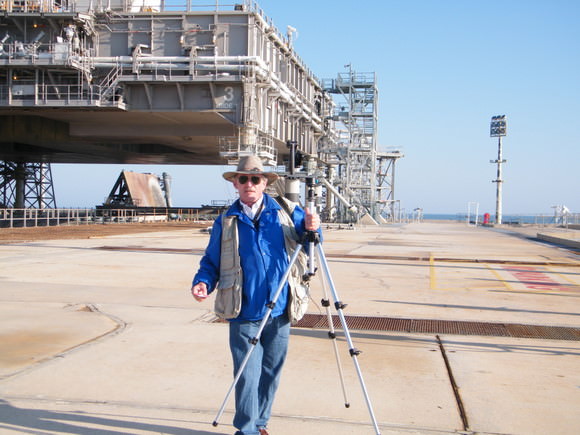
At the end of the proverbial day, space-based missions like Spitzer produce millions of observations of astronomical objects, phenomena, and events. And those terabytes of data are used to test hypotheses in astrophysics which lead to a deeper understanding of the universe and our home in it, and perhaps some breakthrough whose here-on-the-ground implementation leads to a major, historic improvement in human welfare and planetary ecosystem health.
But such missions also leave more immediate legacies, in terms of the pleasure they bring millions of people, via the beauty of their images (not to mention posters, computer wallpaper and screen savers, and even inspiration for avatars).
Some recent results from one of Spitzer’s programs – SAGE-SMC – are no exception.
The image shows the main body of the Small Magellanic Cloud (SMC), which is comprised of the “bar” on the left and a “wing” extending to the right. The bar contains both old stars (in blue) and young stars lighting up their natal dust (green/red). The wing mainly contains young stars. In addition, the image contains a galactic globular cluster in the lower left (blue cluster of stars) and emission from dust in our own galaxy (green in the upper right and lower right corners).
The data in this image are being used by astronomers to study the lifecycle of dust in the entire galaxy: from the formation in stellar atmospheres, to the reservoir containing the present day interstellar medium, and the dust consumed in forming new stars. The dust being formed in old, evolved stars (blue stars with a red tinge) is measured using mid-infrared wavelengths. The present day interstellar dust is weighed by measuring the intensity and color of emission at longer infrared wavelengths. The rate at which the raw material is being consumed is determined by studying ionized gas regions and the younger stars (yellow/red extended regions). The SMC is one of very few galaxies where this type of study is possible, and the research could not be done without Spitzer.
This image was captured by Spitzer’s infrared array camera and multiband imaging photometer (blue is 3.6-micron light; green is 8.0 microns; and red is combination of 24-, 70- and 160-micron light). The blue color mainly traces old stars. The green color traces emission from organic dust grains (mainly polycyclic aromatic hydrocarbons). The red traces emission from larger, cooler dust grains.
The image was taken as part of the Spitzer Legacy program known as SAGE-SMC: Surveying the Agents of Galaxy Evolution in the Tidally-Stripped, Low Metallicity Small Magellanic Cloud.
The Small Magellanic Cloud (SMC), and its larger sister galaxy, the Large Magellanic Cloud (LMC), are named after the seafaring explorer Ferdinand Magellan, who documented them while circling the globe nearly 500 years ago. From Earth’s southern hemisphere, they can appear as wispy clouds. The SMC is the further of the pair, at 200,000 light-years away.
Recent research has shown that the galaxies may not, as previously suspected, orbit around our galaxy, the Milky Way. Instead, they are thought to be merely sailing by, destined to go their own way. Astronomers say the two galaxies, which are both less evolved than a galaxy like ours, were triggered to create bursts of new stars by gravitational interactions with the Milky Way and with each other. In fact, the LMC may eventually consume its smaller companion.
Karl Gordon, the principal investigator of the latest Spitzer observations at the Space Telescope Science Institute in Baltimore, Maryland, and his team are interested in the SMC not only because it is so close and compact, but also because it is very similar to young galaxies thought to populate the universe billions of years ago. The SMC has only one-fifth the amount of heavier elements, such as carbon, contained in the Milky Way, which means that its stars haven’t been around long enough to pump large amounts of these elements back into their environment. Such elements were necessary for life to form in our solar system.
Studies of the SMC therefore offer a glimpse into the different types of environments in which stars form.
“It’s quite the treasure trove,” said Gordon, “because this galaxy is so close and relatively large, we can study all the various stages and facets of how stars form in one environment.” He continued: “With Spitzer, we are pinpointing how to best calculate the numbers of new stars that are forming right now. Observations in the infrared give us a view into the birthplace of stars, unveiling the dust-enshrouded locations where stars have just formed.”
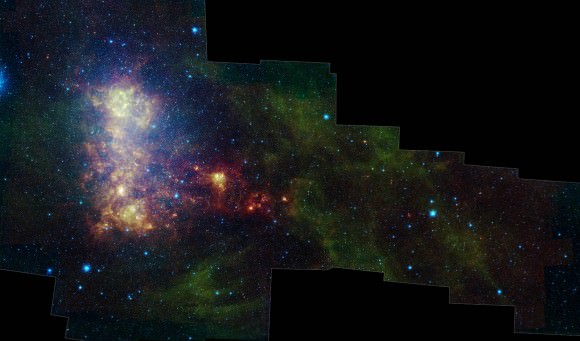
This image shows the main body of the SMC, which is comprised of the “bar” and “wing” on the left and the “tail” extending to the right. The tail contains only gas, dust and newly formed stars. Spitzer data has confirmed that the tail region was recently torn off the main body of the galaxy. Two of the tail clusters, which are still embedded in their birth clouds, can be seen as red dots.
Source: Spitzer
[/caption]
On February 13, 2010, Cassini flew by Saturn’s moon Mimas, coming as close as 9,500 km.
It passed directly over Herschel, a giant crater whose creation almost shattered the moon … and which, in its appearance in some earlier images, earned Mimas the nickname “Death Star”, after the iconic Star Wars prop.
The Cassini team has just released some “Raw Previews” of Cassini’s close encounter; time to feast your eyes.
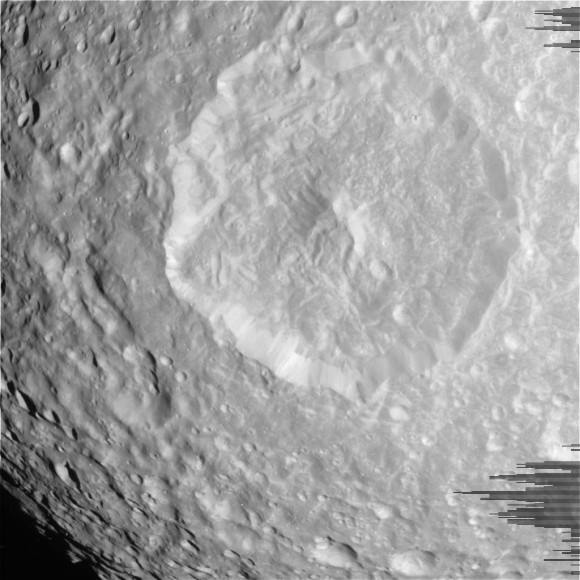
The Cassini Equinox Mission, of which the Mimas flyby is but a small part, is a joint United States and European endeavor. The Jet Propulsion Laboratory, a division of the California Institute of Technology in Pasadena, manages the mission for NASA’s Science Mission Directorate, Washington, D.C. The Cassini orbiter was designed, developed and assembled at JPL. The imaging team consists of scientists from the US, England, France, and Germany. The imaging operations center and team lead (Dr. C. Porco) are based at the Space Science Institute in Boulder, Colo.
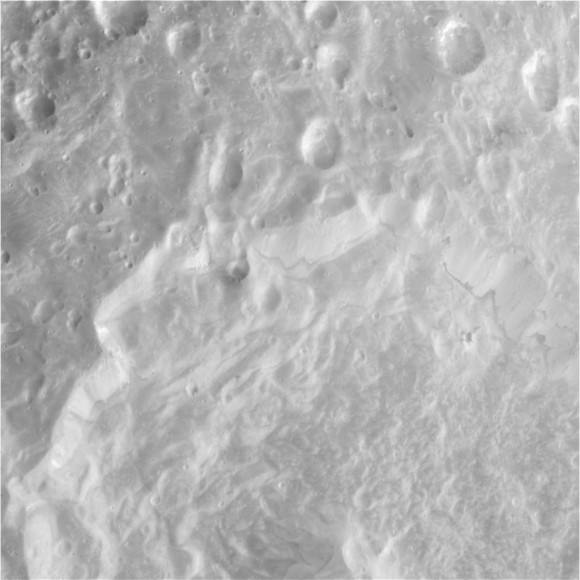
Source: CICLOPS (Cassini Imaging Central Laboratory for Operations)
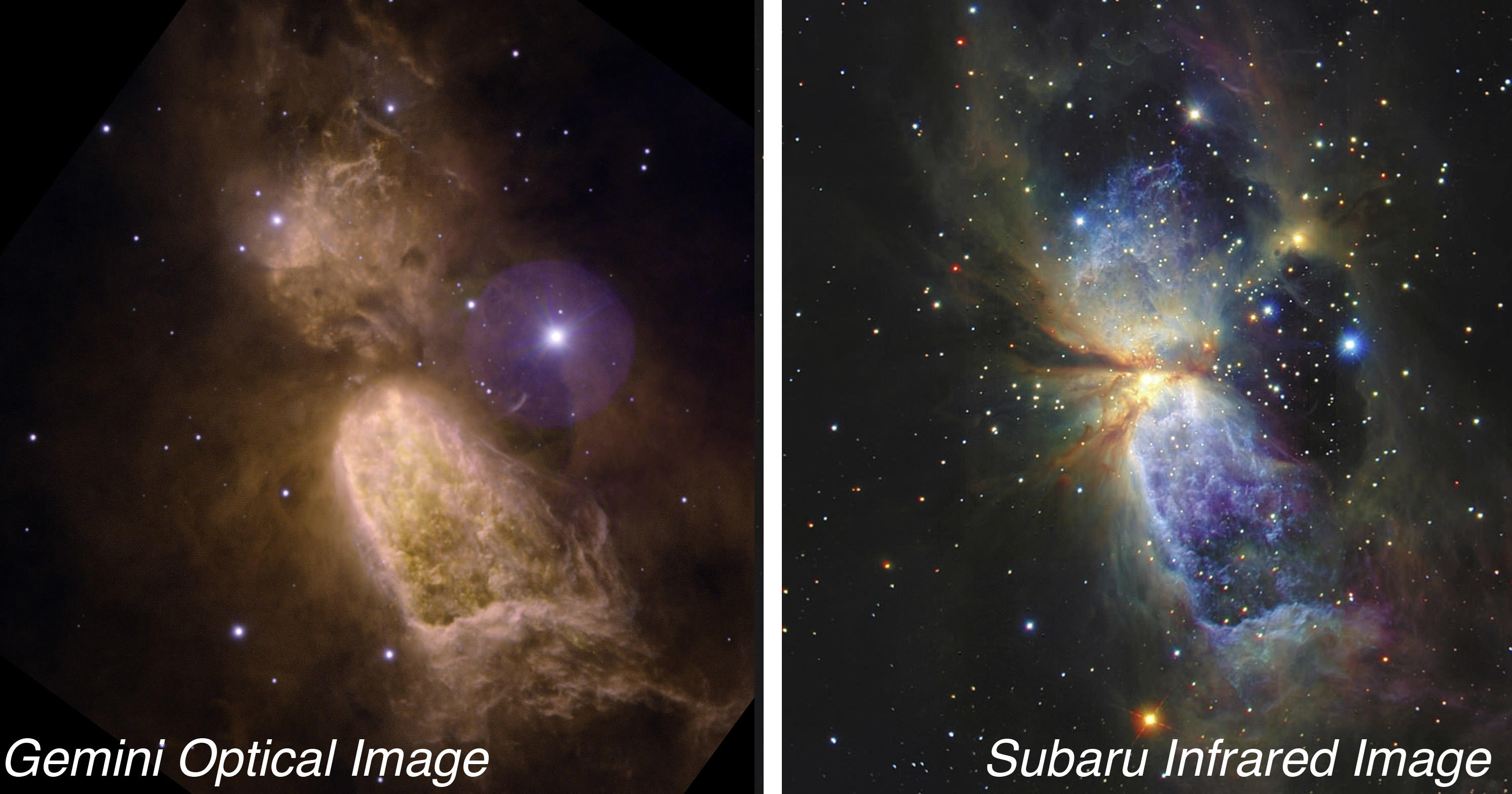
[/caption]
About 2,000 light-years away, in the constellation of Cygnus (the Swan), lies Sharpless 2-106 (after Stewart Sharpless who put the catalog together in 1959), the birth-place of a star cluster-to-be.
Two recent image releases – by Subaru and Gemini – showcase their new filter sets and image capabilities; they also reveal the stunning beauty of the million-year-long process of the birth of a star.
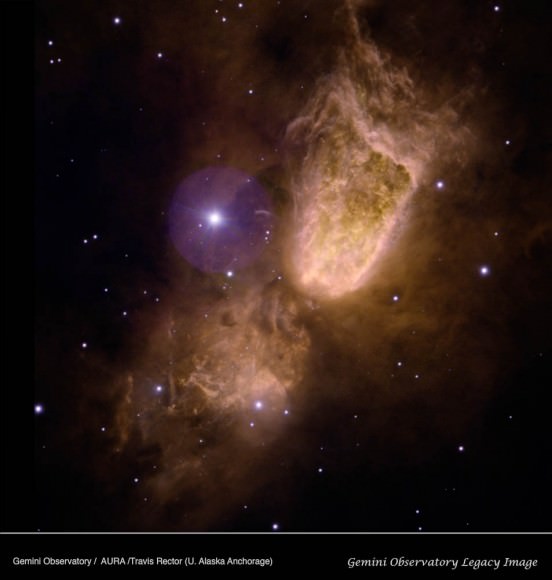
The filter set is part of the Gemini Multi-Object Spectrograph (GMOS) toolkit, and includes ones centered on the nebular lines of doubly ionized oxygen ([OIII] 499 nm), singly ionized sulfur ([SII] 672 nm), singly ionized helium (HeII 468nm), and hydrogen alpha (Hα 656 nm). The filters are all narrowband, and are also used to study planetary nebulae and excited gas in other galaxies.
The hourglass-shaped (bipolar) nebula in the new Gemini image is a stellar nursery made up of glowing gas, plasma, and light-scattering dust. The material shrouds a natal high-mass star thought to be mostly responsible for the hourglass shape of the nebula due to high-speed winds (more than 200 kilometers/second) which eject material from the forming star deep within. Research also indicates that many sub-stellar objects are forming within the cloud and may someday result in a cluster of 50 to 150 stars in this region.
The nebula’s physical dimensions are about 2 light-years long by 1/2 light-year across. It is thought that its central star could be up to 15 times the mass of our Sun. The star’s formation likely began no more than 100,000 years ago and eventually its light will break free of the enveloping cloud as it begins the relatively short life of a massive star.
For this Gemini image four colors were combined as follows: Violet – HeII filter; Blue – [SII] filter; Green – [OIII] filter; and Red – Hα filter.
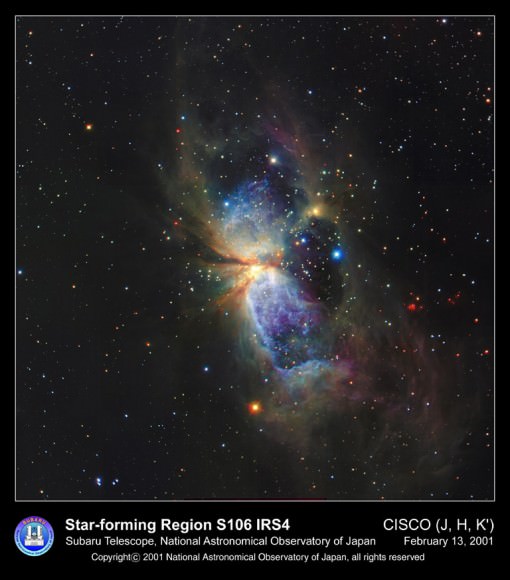
The Subaru Telescope image was made by combining images taken through three broadband near-infrared filters, J (1.25 micron), H (1.65 micron), and K’ (2.15 micron).
Sources: Gemini Observatory, NAOJ
OK, it’s actually the Herschel crater on Mimas, a smallish moon of Saturn (and it’s the eve of Chinese New Year, February 13th, 2010), but it’s a cool headline, don’t you think?
Cassini will be very busy that day, which begins with a rare sunrise – the Sun goes behind Saturn (from Cassini’s perspective) – followed by a rare blackout, as the Earth goes behind Saturn. Then there’s three “Forward shields up!” moments, as Cassini tries to dodge a Klingon missile flies through regions of “increased ring particle concentration”, a couple of distant flybys (Epimetheus, Janus; ~100,000 km each), a ring-plane crossing, another “Shields up!” moment, and a 9,500 km close approach to Death Star Mimas. And the day ends with a distant (112,000 km) flyby of Tethys. Whew!
“Mimas bears the mark of a violent, giant impact from the past – the 140-kilometer-wide Herschel Crater – and scientists hope the encounter will help them explain why the moon was not blown to smithereens when the impact happened. They will also be trying to count smaller dings inside the basin of Herschel Crater so they can better estimate its age,” JPL’s Jia-Rui C. Cook said, “The Mimas flyby involves a significant amount of skill because the spacecraft will be passing through a dusty region to get there. Mission managers have planned for the Cassini spacecraft to lead with its high-gain antenna to provide a barrier of protection.”
To date, the best images of Mimas – and its Herschel crater – were obtained on August 2nd, 2005, during Cassin’s distant flyby.
Mimas is an inner moon of Saturn that averages 396 kilometers in diameter. The diameter of Herschel Crater is about one-third that of the entire moon. The walls of the crater are about 5 kilometers high, and parts of the floor are approximately 10 kilometers deep.
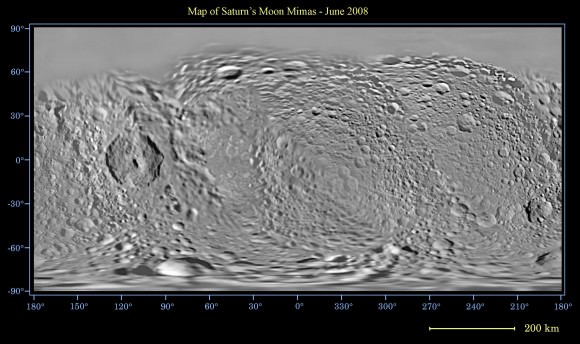
Mimas would have beaten another of Saturn’s moons, Rhea, for the record of “most battered moon”, but for the fact that it was warmer – and so softer – for longer than Rhea (because it’s closer to Saturn), so many of the earliest craters were more degraded.
Have you heard of the “Mimas paradox”? Mimas’ orbit is more eccentric than Enceladus’, and is in resonance with Dione and Enceladus – so it should be heated, tidally, more than Enceladus – but its surface has not, apparently, changed for a very long time (while geysers on Enceladus show that it is still quite active). Further, the two moons seem to have similar compositions.
On this flyby, Cassini’s composite infrared spectrometer will be working to determine the thermal signature of the moon, and other instruments will be making measurements to learn more about the surface composition. Perhaps that will shed some light on the Mimas paradox.
Sources: Cassini Set to Do Retinal Scan of Saturnian Eyeball, Mimas (NASA/JPL)
Want a nebula wallpaper to put as the background image of your computer desktop? Here’s a handful of nebula images. To make any of them your computer’s background image, just click on the image to see a larger version. Then right-click on the image and choose to set the image as your desktop background.
The nebula wallpaper is the Flame Nebula, captured by the European Southern Observatory. Also known as NGC 2024, it’s a famous nebula located about 1,500 light-years away in the constellation of Orion. The bright star at the top of the image is Alnitak, one of the belt stars of Orion.
This is a wallpaper image of the Crab Nebula taken by the Hubble Space Telescope. Also known as M1, the Crab Nebula is the results of a supernova explosion that occurred almost 1000 years ago. Astronomers in 1054 AD reported a star brighting in the sky, and lasting for a few weeks before it dimmed again. That was the supernova that went on to create the Crab Nebula.
This is a wallpaper of the Butterfly Nebula (or NGC 6302) captured by Hubble. This is a planetary nebula, the result of a dying star blasting out its outer layers into space. This is what our own Sun might do in about 7 billion years from now after it becomes a red giant star.
This is Hubble Space Telescope image of the Ring Nebula, also known as M57. It’s actually a planetary nebula, where the outer layers of a dying star are puffed out into space. The Ring Nebula is located about 4000 light-years away, and measures about 500 times larger than the Solar System.
This is the Carina Nebula, photographed by the Hubble Space Telescope. This is just one pillar of gas and dust in the nebula, measuring 2 light-years across. It’s located about 7,500 light years from Earth.
We’ve written many articles about nebulae for Universe Today. Here’s an article about dust in the Iris Nebula, and here’s an article about Hubble images of the Helix Nebula.
If you’d like more information on nebulae, check out NASA’s Photo Gallery of Nebulae, and here’s a link to the Hubblesite Homepage for recent stories and images.
We’ve recorded an episode of Astronomy Cast all about nebulae. Listen here, Episode 111: Nebulae.
Here are some amazing images of space:
This is an amazing image of the Moon taken from the International Space Station orbiting Earth. What a view!
This is a photograph of the spiral galaxy M83, one of the closest best examples we can see of a spiral galaxy. This image was captured by the Hubble Space Telescope.
Here’s an image of Hurricane Ike captured by astronauts on board the International Space Station.
Here’s a photo of NASA’s Apollo 11 lunar lander rising from the surface of the Moon to dock with the Command and Service module.
Here’s a picture of Halley’s comet taken by the Giotto spacecraft. You can see the nucleus of the comet tumbling in space and the tail trailing behind.
If you’d like to get more outer space pictures for yourself, check out NASA’s Astronomy Picture of the Day, as well as NASA’s Image of the Day.
Many of the best pictures of space come from the Hubble Space Telescope. You can see the latest images from the Hubble Site, and then an archive of old images at the Hubble Heritage site. There are also great pictures from the Chandra X-Ray Observatory and NASA’s Spitzer Space Telescope.
If you’d like pictures of the planets, check out NASA’s Planetary Photojournal, and here are links to missions at the planets in the Solar System. MESSENGER, Venus Express, the Lunar Reconnaissance Orbiter, Mars Reconnaissance Orbiter, Cassini, and New Horizons.
We’ve written many articles about amazing images for Universe Today. Here’s an article about some images from STS-129, and here are some images of the shuttle and Hubble transiting across the Sun.
We’ve recorded many episodes of Astronomy Cast about space. Try this one, Episode 99: The Milky Way.
NASA has the absolute best resources on the web for pictures of space. We write so many articles about space here on Universe Today, so we’ve learned all the best places to look to get the latest and greatest NASA pictures.
Before we go right to some sites, here’s a general tip that you can use when you’re looking for NASA pictures. Use Google, but have it search for images within NASA’s sites. For example, let’s say that you’re looking for an astronomy picture of Mars, but you want it to be a NASA image. Search in Google for: mars picture site:nasa.gov. You can also switch over to the images tab and see lots and lots of images from NASA. You should be able to find the one you’re looking for.
Perhaps the best place to start is NASA’s Featured Images and Galleries. This is linked from the main NASA page and features current pictures as well as classics from the past. It also links you to other NASA image gallery sites.
Another classic is the Astronomy Picture of the Day. Keep in mind that although it’s endorsed by NASA, the pictures featured in Astronomy Picture of the Day are owned and copyright by the original photographers. So you can’t just use their pictures without asking permission first.
There’s a fairly new service out called NASA Images. It’s got a huge catalog of NASA pictures, with cool tools that let you organize and download your favorites.
The NASA Image Exchange is a huge database of NASA pictures. You can search by object, or by spacecraft and use other constraints to find the exact image you’re looking for.
The Johnson Digital Image Collection has photographs from all of NASA’s human spaceflight, from the original Mercury and Gemini flights, though the Apollo landings, right up until the space shuttle missions.
And if you want pictures of Earth, check out NASA’s Visible Earth site or the NASA’s Earth Observatory.
If you want pictures from the Hubble Space Telescope, here’s their homepage HubbleSite.
Want NASA photos from specific spacecraft? Here’s NASA’s Cassini spacecraft, here are the Mars Exploration Rovers, and here’s Mercury MESSENGER.
That should get you started.
We have written many articles about NASA and its photography here on Universe Today. Check out this gallery of images from the STS-127 shuttle mission. And here are images from the shuttle mission to repair the Hubble Space Telescope.
We have also recorded many episodes of Astronomy Cast about space, and we talk about NASA pictures all the time. Listen to this, Episode 88: The Hubble Space Telescope.